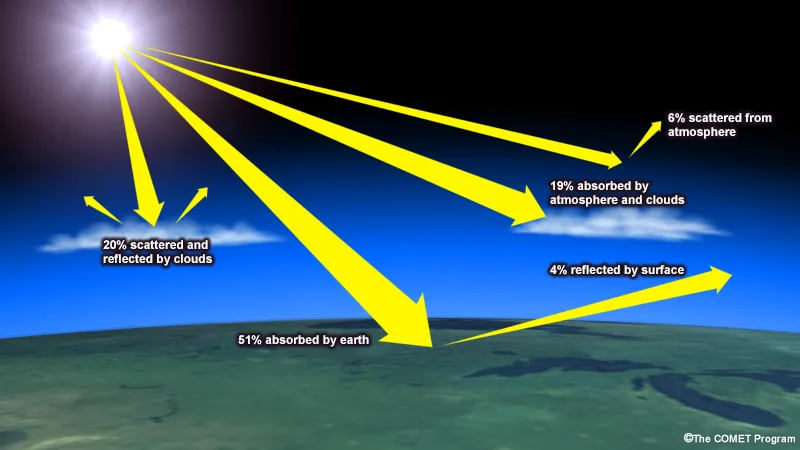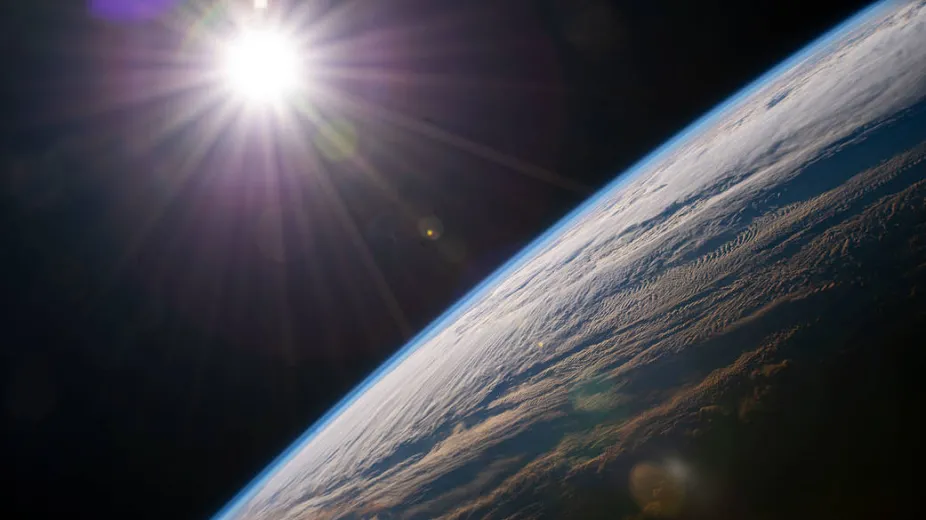The Sun's Energy: An Essential Part of the Earth System
Solar radiation, or energy produced by the Sun, is the primary energy source for most processes in the Earth system and drives Earth’s energy budget.

The Sun is the primary energy source for our planet’s energy budget and contributes to processes throughout Earth.
UCAR/The COMET Program
Energy from the Sun is studied as part of heliophysics, which relates to the Sun’s physics and the Sun’s connection with the solar system.
How Does Energy from the Sun Reach Earth?
It takes solar energy an average of 8 ⅓ minutes to reach Earth from the Sun. This energy travels about 150 million kilometers (93 million miles) through space to reach the top of Earth’s atmosphere. Waves of solar energy radiate, or spread out, from the Sun and travel at the speed of light through the vacuum of space as electromagnetic radiation. The majority of the Sun’s radiation reaching Earth is in the form of visible light we can see and invisible infrared energy that we can’t see. A smaller portion of sunlight is made up of ultraviolet radiation, which is also invisible to our eyes.

Most of the Sun’s energy reaching Earth includes visible light and infrared radiation but some is in the form of plasma and solar wind particles.
NASA
Other forms of radiation from the Sun can reach Earth as part of the solar wind, but in smaller quantities and with longer travel times. The solar wind contains plasma and particles and can also include gamma rays and x-rays resulting from solar storms or other bursts of energy from the Sun’s surface.
The Energy We Receive Depends on Distance From the Sun
The Sun’s energy travels as electromagnetic radiation through space or a medium in the form of waves or particles. If we think about all the wavelengths contained in solar radiation, the total energy output, or luminosity, of the Sun is about 3.86 x 1026 or 3,860 trillion trillion watts, where a watt corresponds to the energy radiated per unit time. Based on the distance from the Sun to Earth (about 150 million kilometers or 93 million miles) and the comparatively small size of Earth, the fraction of the Sun's luminosity reaching our planet is 1.75 x 1017 or 175 quadrillion watts. A quadrillion is 1000 trillion, so the luminosity reaching Earth, even as far away as we are from the Sun, is still a very large number.
We can also think about the Sun's energy in terms of the light we see. If we ignore the other wavelengths and focus just on the visible light from the Sun, we can use a unit called a lumen to measure brightness. The Sun is mind-bogglingly bright, shining at about 36 octillion (3.6 x 1028) or 36 thousand trillion trillion lumens. This brightness (or intensity) falls off with distance from the source by a factor of 1/d2, where d2 is the square of the distance. From the surface of Mercury, depending on the planet's position in its orbit, the Sun would appear from seven to eleven times brighter as it does when viewed from Earth. By the time the Sun's energy reaches Earth's surface, it has a globally averaged brightness of about 127,000 lumens per square meter. The intensity of sunlight reaching a particular spot on Earth at any time depends on location and time of year, as lower sun angles spread the incoming energy over a larger surface area.

The Sun is 93 million miles from Earth, yet it still provides us with all of the energy needed to sustain life.
NASA
The Sun’s Energy is Important to Life on Earth
Energy from the Sun makes it possible for life to exist on Earth. It is responsible for photosynthesis in plants, vision in animals, and many other natural processes, such as the movements of air and water that create weather. Most plants need at least some sunlight to grow, so without light, there would be no plants, and without plants, there would not be oxygen for us to breathe. Infrared radiation from the Sun is responsible for heating the Earth’s atmosphere and surface. Without energy from the Sun, Earth would freeze. There would be no winds, ocean currents, or clouds to transport water.

Energy from the Sun enables photosynthesis in plants, which provides the oxygen we breathe and helps grow the food we eat.
Creative Commons Stephen Bowler
How do Humans Benefit from the Sun's Energy?
Throughout history, humans have used technology to harness the Sun’s energy as a source of light and heat and for growing crops. As early as 30 CE, people were constructing greenhouses to grow plants out of season. Did you know that one of the earliest greenhouses was built for the Roman emperor Tiberius using translucent sheets of mica, all so that he could eat cucumbers in any season?
Early civilizations knew that setting up shelters to capture or block sunlight could help with heating and cooling. In cold climates, they would position buildings to face southward, allowing interior spaces to gather heat and light. In warm climates, shelters might be constructed under cliffs or natural overhangs to protect the residents from the Sun’s radiation in the hottest part of the day. Using energy from the Sun effectively also helped with growing crops.

The cliff dwellings at Mesa Verde National Park in Colorado, USA, were built in the shadows of rock overhangs to help keep the structures cool in the hot desert sunlight.
Creative Commons Steven Zucker
Today, we can intentionally position windows and skylights to help heat or cool our homes through passive solar design. Solar panels can also capture energy from the Sun by gathering sunlight and converting it to electricity. As of 2023, solar power is the third largest source of renewable energy worldwide, behind hydropower and wind.
How is Energy from the Sun Harmful?

UV radiation can damage skin and cause sunburn, but simple actions such as wearing a hat and sunscreen provide essential protection from the Sun’s harmful UV rays.
EPA
Some of the Sun’s energy reaches Earth in the form ultraviolet (or UV) radiation. Fortunately, the ozone layer high in Earth’s atmosphere absorbs a lot of this UV radiation and blocks it from reaching Earth’s surface. But some UV still makes it through. UV radiation from the Sun causes sunburn and skin damage but can be blocked with clothes and sunscreen. Wearing hats and sunglasses in bright sunlight and trying to stay in the shade when possible can also help protect you from harmful UV rays. Note that it’s not realistic or advisable to avoid all exposure to sunlight, as sunlight also helps our bodies produce vitamin D, which we need to be healthy.
UV radiation can damage plants and limit photosynthesis. Scientists have found that overexposure to UV radiation reduces size, productivity, and quality in several crop species, including many varieties of rice, soybeans, winter wheat, cotton, and corn. Sometimes, UV can cause bleaching of plants, visible as damage or discoloration. Planting tender young plants in the shadow of larger plants can help protect them from UV radiation.